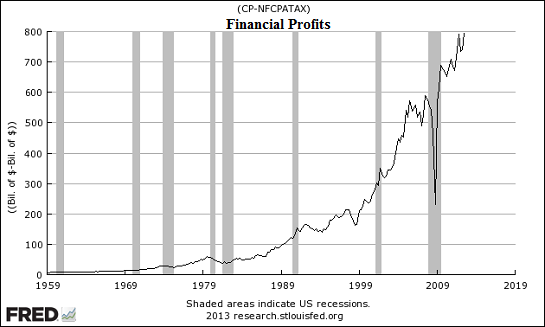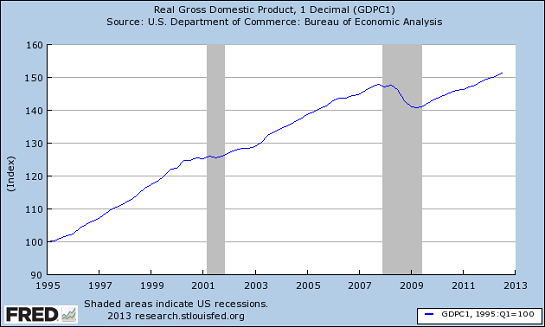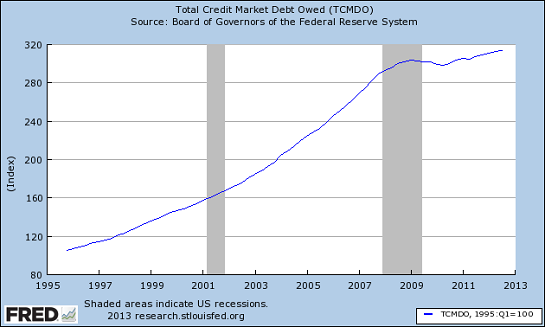A mere dozen points describe both the global financial illness and the cure.
The global economy is ill, and everyone who is not mired in denial or a paid shill knows it. Saying it's healthy doesn't make it so.
Is is possible to usefully generalize the illness and outline a cure in a few points?Maybe not, but let's try anyway.
1. Creating and selling credit and leverage became far more profitable than generating goods and services. Financialization--expanding highly profitable credit by leveraging assets and income to the hilt--began in earnest in the early 1980s.
Creating credit is equally easy in fractional reserve systems like the U.S. and command economies like China. Creating leveraged instruments is as easy as writing and selling derivatives, which not coincidentally have risen (in notional value) 700% since the mid-1990s.
We can understand financialization with just two charts: Here is real GDP, up 50%:
Here is total credit market debt owed, up 200%:
Though solid data is hard to come by, financialization is not just more profitable in nominally capitalist America--it is also true in nominally communist China. Real estate speculation is simply the expansion of credit via building phantom assets.
2. The financial sector captured the regulatory and political mechanisms of the Central State. This capture is both direct (buying political relief from regulation, etc.) and indirect: once the market becomes dependent on financial profits, then any threat to those profits threatens the market and thus the wider economy.
Politicians, capitalist, socialist and communist alike, all cave in as soon as economic growth is at risk.
The capture was also ideological. In the West, neoliberal policies (loosening regulatory controls, reducing the size of the State, enabling free flow of capital, etc.) produced huge gains in growth in the initial low-hanging-fruit stage. This gave the ideology real-world credence.
In China, the "to get rich is glorious" slogan embodied an entire ideology of a State-managed market economy that was as dependent on financialization as the West. (In China, financialization is hidden in land deals and loans made by local government and private wealth-management credit/leverage that is off the books.)
3. Financialization incentivized speculative credit bubbles. Speculation reaps huge rewards as the bubble expands, and the economy becomes increasingly dependent on ever-expanding debt for its growth, income, profits and taxes.
When the bubbles burst, they devastate not just the financial sector but the entire economy, which has become heavily dependent on speculative bubbles and continuous expansion of debt and leverage for its growth.
4. The only "cure" that doesn't cause political pain is to lower interest rates and flood the economy with liquidity, i.e. cheap money, to reflate a new credit bubble in another asset class. If there are no other asset classes available, then the Central State and Bank will try to reflate the existing bubble (for example, real estate in China).
5. Speculative credit bubbles (neoliberal or command-economy) led to systemic mal-investment and mis-allocation of capital. Suddenly selling autos for a loss to reap the financing fees made sense, as did building McMansions in the middle of nowhere and building more steel mills in China, even though the sector is already plagued with monumental over-capacity.
6. The Central State and Bank responded to the popped speculative credit bubbles by recapitalizing insolvent banks with taxpayer money (or claims on future taxpayers, i.e. bonds) and legitimizing phantom collateral/assets. It is absolutely critical to understand that the political Status Quo will "buy" growth at any price, and as a result the State is blind to the consequences of massive mis-allocation of scarce real capital in mal-investment.
In other words, the State and Central Bank will continue to do more of what has failed spectacularly until they can no longer do so.
The ultimate counterfeited collateral/asset is a sovereign bond. Here is the basis of the claimed legitimacy: "We can always pay the interest on this bond because we have the unlimited power to tax our citizenry, and we will always return your capital because we have the unlimited power to create money."
Yet if we follow the consequences of these two unlimited powers, we find nations taxed into poverty and currency debauched to a shadow of its former value. How exactly does ruining the economy and currency create legitimate collateral?
The State also legitimizes phantom capital by manipulating stocks and bonds higher and allowing real estate to be marked-to-fantasy or kept off the market.Only a transparent, open market can discover the price of an asset and thus its value as collateral for debt, and destroying or limiting the market's ability to price assets undermines the legitimacy of all assets and collateral.
7. The Central State and Bank attempted to repair the speculative credit bubble machine by diverting income from the productive "real" private economy to the parasitic financial sector and politically powerful but grossly inefficient cartels and State fiefdoms.
8. The demographics of an aging population and shrinking workforce cannot support the promised entitlements and other State spending. This has been covered in depth in many places, including this blog--for just one example of dozens:
Demographics and the End of the Savior State (May 17, 2010).
That's the core of the disease in 8 points. Here is the 4-point cure:
1. Re-take the regulatory and political machinery of the State from the control of the financial sector. As long as the State and Central Bank's actions are primarily aimed at sustaining debt bubbles and spreading the losses generated by the financial sector to the rest of the economy, the State and the economy are doomed to implosion:
Is the Central State Too Big to Fail or Too Big to Survive? (January 22, 2013)
2. Mark every marketable asset held by every financial institution and corporation to market at the close of each day, including mortgage-backed securities and real estate. This will reveal the "too big to fail" banks around the world as insolvent.
3. Liquidate the insolvent banks in an orderly fashion by auctioning off all of their assets on the open market. This will eliminate the shadow inventory of housing and expose phantom collateral.
4. Relieve the State of all obligations other than being an impartial enforcer of transparent markets, open competition and common-sense regulation to protect the common good and public commons. As I explained in
The Grand Tradeoff of Risk/Innovation/Growth and Financial Security (January 21, 2013), the security of State guarantees and promises is illusory: the State can only sustainably spend the surplus generated by the private sector.
As the private sector crumbles under the dead weight of a parasitic financial Aristocracy, the debt-serfdom of financialization and corrupt, inefficient State fiefdoms, the economy can no longer support expanding State obligations and debt.
The citizenry will have to accept that promises issued on the basis of delusional, unrealistic projections of endless growth and debt expansion must be renounced, just as debt based on phantom collateral must be renounced.
Were these four points implemented, the re-set would be difficult but brief, as truth, trust and resilience would be restored to the political and financial systems. Once political and financial resilience has been restored, fixing all the other problems we face enters the realm of the possible. Without these 4 fixes, the system remains brittle, fragile and doomed to implosion.
Things are falling apart--that is obvious. But why are they falling apart? The reasons are complex and global. Our economy and society have structural problems that cannot be solved by adding debt to debt. We are becoming poorer, not just from financial over-reach, but from fundamental forces that are not easy to identify or understand. We will cover the five core reasons why things are falling apart:
 1. Debt and financialization
1. Debt and financialization
2. Crony capitalism and the elimination of accountability
3. Diminishing returns
4. Centralization
5. Technological, financial and demographic changes in our economy
Complex systems weakened by diminishing returns collapse under their own weight and are replaced by systems that are simpler, faster and affordable. If we cling to the old ways, our system will disintegrate. If we want sustainable prosperity rather than collapse, we must embrace a new model that is Decentralized, Adaptive, Transparent and Accountable (DATA).
We are not powerless. Not accepting responsibility and being powerless are two sides of the same coin: once we accept responsibility, we become powerful.
Kindle edition: $9.95 print edition: $24 on Amazon.com
To receive a 20% discount on the print edition: $19.20 (retail $24), follow the link, open a Createspace account and enter discount code SJRGPLAB. (This is the only way I can offer a discount.)
| Thank you, Don S. ($100), for your outrageously generous contribution to this site -- I am greatly honored by your support and readership. | | Thank you, Robert B. ($10), for yet another most generous contribution to this site --I am greatly honored by your steadfast support and readership. |



 1. Debt and financialization
1. Debt and financialization

























